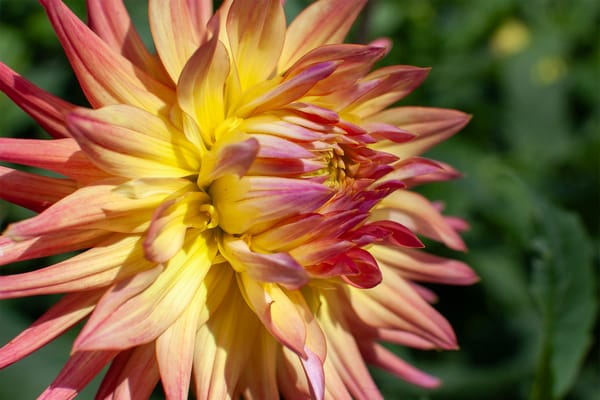The wild Atlantic breathes life into Cornwall’s dramatic coastline—and gardeners here know that wind is both a sculptor and a challenge. Along cliff-edge plots or tucked behind the shelter of weathered Cornish stone walls, growing dahlias by the sea becomes a poetic test of resilience, creativity, and quiet defiance against nature’s unruly hand.
The Poetry and Challenge of Coastal Growth
In Cornwall, where the land meets the restless sea, gardens tell stories shaped by the wind. From the salt-laden breezes of St Ives to the roaring gales of Land’s End, coastal gardens are places of contrasts:
Blousy dahlias—rich in colour and exuberant in form—can be flung about by sudden gusts or stand resplendent in calm, sunlit pockets. The sea’s briny breath threatens salt burn and brittle stems, yet tempers the climate with a gentler hand, shielding gardens from the deeper frosts felt inland.
To grow dahlias here is to learn a dance with the elements—a gardener’s duet with wind, weather, and sea. Every bloom that unfurls in a Cornish coastal garden tells a story of grit, grace, and the ever-present hope of a late summer border ablaze with colour against a backdrop of slate-blue surf.
Practical Strategies: Thriving Against the Winds
Shelter Is Survival
The first rule of coastal gardening? Respect the wind. Shelter isn’t a luxury—it’s a necessity.
Traditional Cornish gardens thrive within the embrace of granite walls, high hedges, or rustic fences woven from hazel or willow. These barriers break the wind’s charge, turning gales into gentle breezes. Evergreen hedges—griselinia, escallonia, or olearia—serve as living windbreaks, softening salty gusts and providing sanctuary for delicate stems.
Staking: Art and Necessity
Along the coast, staking dahlias isn’t optional—it’s an art form. Robust support is vital. Forget slender canes; coastal growers favour sturdy bamboo poles, metal stakes, or solid wooden posts, driven deep into the ground.
Ties should be gentle but firm—soft twine or padded ties spaced low on the stem, with more added as the plant rises. And in truly exposed gardens, a “corral” of string around groups of dahlias lets them lean with the wind’s pull, rather than snap against its force.
Salt Tolerance and Selection
Though dahlias thrive in Cornwall’s fertile, moisture-retentive soils, they shudder under direct salt spray. Proximity matters—the further from the cliff edge, the better.
Compact, robust varieties—like ball types or dark-leaved cultivars such as ‘Bishop of Llandaff’—often prove hardier against the sea air. Large, dinner-plate dahlias, while stunning, demand the best shelter: behind hedges, within walled gardens, or tucked against sunny, south-facing walls.
Soil Health and Mulching
Cornwall’s coastal soils can be a paradox—sandy loams that drain swiftly after rain but parch quickly in summer winds. For dahlias, this means building richness beneath the surface.
Well-rotted compost, aged manure, or leafmould folded into the soil boosts fertility and moisture retention. An annual mulch insulates tubers from drying winds and nourishes the bed, creating a slow-release pantry beneath the plants.
Smart Siting and Succession
In coastal gardening, success often lies in seeing the microclimates that others miss—the lee of a hedge, the shelter of a boulder, the suntrap corner that escapes the brunt of a prevailing gale.
Pots and raised beds offer a mobile solution in exposed sites, allowing dahlias to be positioned perfectly or even relocated as seasons shift. In more forgiving spots, layering planting with taller companions like verbena or sturdy grasses provides natural buffering.
Border Companions and Cornish Inspiration
In Cornish coastal borders, dahlias rarely stand alone. Their flamboyant forms pair best with plants that offer movement, resilience, and contrast:
- Ornamental Grasses (Molinia, Pennisetum) sway gently in the wind, softening the visual impact and absorbing gusts.
- Verbena bonariensis weaves airy purple clouds among dahlia stems, adding height and drawing pollinators.
- Agapanthus and Crocosmia lend architectural spikes and fiery hues, harmonising with dahlia boldness.
- Perennials like echinacea, rudbeckia, or aster provide rhythm, while dense foliage plants like alchemilla mollis cradle the base of taller flowers.
A well-planned coastal border mirrors Cornwall’s own landscape—bold, layered, and alive with colour and movement.
Catching the Wind: Gardeners’ Reflections
To grow dahlias by the sea is to accept that nature is both adversary and muse. Each season, the wind strips back the weak and leaves the strongest blooms standing tall—petals kissed by salt air, stalks swaying with grace.
In Cornwall, we don’t conquer the wind. We listen to it, read the way it moves through a garden, and plant with its whispers in mind. Shelter, support, soil—these are our tools. Patience, creativity, and a pinch of stubbornness are our allies.
The reward? Borders alive with colour, dahlias glowing in the shifting light of the Atlantic coast, telling a story of resilience and beauty shaped by the very forces that threaten it.
Quick Table: Coastal Dahlia Essentials
| Challenge | Solution | Cornish Tips |
|---|
| Wind | Sturdy staking, windbreaks, corrals | Granite walls, living hedges, grouping plants |
| Salt | Site with shelter, robust varieties | Avoid cliff edges, favour ball and dark-leaved types |
| Fast-draining soil | Organic mulch, compost, regular water | Use leafmould, mulch annually |
| Exposure | Microclimate planting, grouped dahlias | Plant in dips, behind walls, or near hedges |
With thoughtful choices and a gardener’s eye for shelter and beauty, dahlias become coastal jewels—dancing with the wind, glowing against the sea, and embodying the enduring spirit of Cornish gardens.











